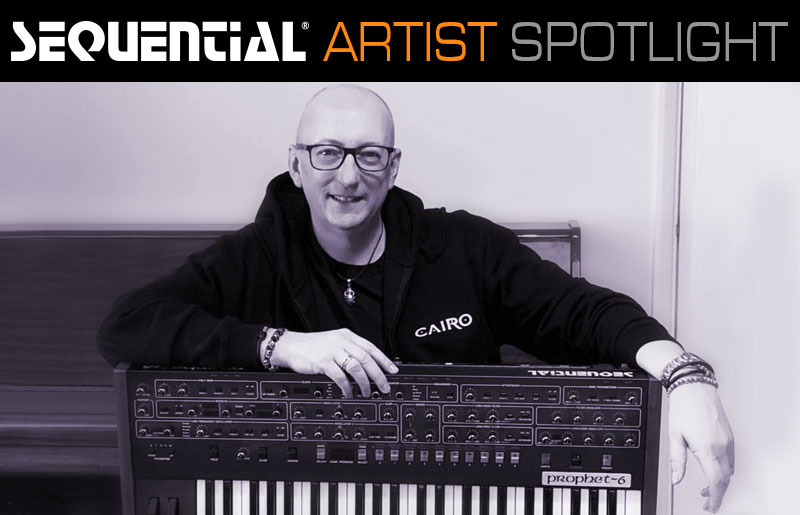
Rob Cottingham was born in Peterborough in Cambridgeshire, UK. He is the youngest of three children born to George and Maisie Cottingham. He grew up in the town of Bedford, and from a young age he was fascinated to look up at his mother playing piano and singing songs from classic musicals, such as West Side Story and Fiddler on the Roof. He learnt piano whilst at school from the age of nine to sixteen.
In the early days, he formed a school band called ‘Telpa Europa’ (Latin for ‘earthworm’). As Rob says ‘great name not so great band!’. A few years later, in the early ’80’s, he and boyhood friend Andrew Wildman collaborated to form a contemporary rock band called ‘Cinema’ and wrote the concept album ‘Golden Ring’ which was the first indication of his progressive rock leanings. In the early 90’s, Rob gigged regularly on keyboards with a Rhythm ‘n’ Blues band, The Waterbreakers. This gave him extensive gigging experience as well as an insight into, and an overview of, a different musical genre. He was, however, always itching to write his own material, work on developing his own musical style, and form a band in which he could express himself. Rob then formed ‘Ghost’ in late 1995 with Andrew Wildman, and became the main writer and core of the group, at which time they met guitarist Michael Daly, and the ‘Ghost’ sound was born – gigging with covers from Pink Floyd, Simple Minds, Seal and the like. In 1999/2000 Rob was then heavily involved with developing and composing parts of the music for ‘The Orpheus Project’ which included a classical piano piece written by Rob especially for this new millennium project. The next natural progression for Rob was to write, arrange and produce his own solo album – the result of which is his thought-provoking album – ‘Behind The Orchard Tree’ – recorded at Linford Manor Studios (Jamiroquai, Feeder, Skunk Ananse etc) in Milton Keynes, UK and released in March 2002.
We chatted with Rob on how he uses the Prophet-6 in his music:
What made you choose the Prophet-6?
The Prophet-5. I have admired Prophets and “that sound” since first immersing myself in synthesis in my late teens, when I first started tinkering around with a second-hand Transcendent 2000 mono synth kit, courtesy of my father. It eventually fell to pieces but it was my first proper synth — if you ignore Stylophones. Around that time, in the 80s, the Prophet-5 was for me financially unobtainable but I loved that sound, which was being played by some gods of the music industry.
Back in 2018, Musicradar published their view of the ten greatest synths of all time and the Prophet-5 was unsurprisingly in the top three. It had become a market leader and industry standard for many to aspire to in the 80s. It was used by Michael Jackson (Thriller is a prime example), Tangerine Dream, Talking Heads, Madonna, and Radiohead to name but a few. John Carpenter used just a Prophet-5, with its spooky analogue textures, and a piano on 1982 horror film “Creepshow.” The follow up Prophet-10 was used to record the soundtrack for “The Terminator” in 1984.
Iconic stuff.
So, I have opted for a Prophet-6, which is based on an updated version of that legendary and groundbreaking synth. It simply had to be my first choice.
How are you using it?
A Prophet is one of those synths I have always secretly wanted to add to my sonic armoury, which revolves around a Kurzweil PC3K and the Korg Kronos, which for years I never quite got around to sorting out. I’m so looking forward to adding a Prophet-6 electronica vibe, together with heavier guitar work, to Cairo’s next studio album and all my future projects.
I created a demo called “What’s in the Box?” within literally hours of getting my hands on the synth. Apart from the drums, all the sounds you hear are from the Prophet-6.
What’s one of your favorite things about it?
In terms of sound design, it’s intuitive and easy to use. It took me only around an hour to get to grips with the keyboard and start producing some happening riffs. The pre-programmed sounds are inspirational to get you started on ideas. It’s a real powerhouse in a small 49-note packet.
In terms of aesthetics, I love the red glow from the control wheels, and generally the red vibe from the controls. Goes beautifully with my monochromatic studio. If you are a fan of “Sin City” you’ll know what I am getting at — big black and white and red rock style.
What does it give you that other synths might not?
That classic Prophet warm analog sound which spans generations. It appeals just as much today as it did in the 80’s because it’s based on the fundamental analog principles of sound synthesis — but with the Sequential heart and soul which is difficult to put your finger on, but is most definitely there.
Any interesting tricks or techniques you’d like to share?
Use “Slop” with care but don’t be afraid to use it with gusto. And the dual effects are to die for to add extra sauce to the raw sound. Also, Resonance and Distortion at the right balance give any unison sounds you want to use for lead line lines real beef, especially if you add a bit of glide.
There is only one way to find out with this beautiful keyboard, and that is to experiment and not be afraid to go “off piste.”
LINKS
facebook.com/RobCottinghamMusician
MORE ABOUT SEQUENTIAL
For more information, check out the Sequential product page.
Find your local dealer for pricing.
If you’re using Sequential products in interesting ways, tell us about it. Contact us at .
